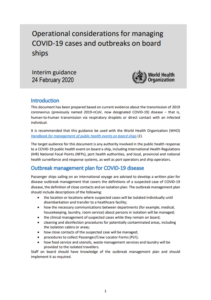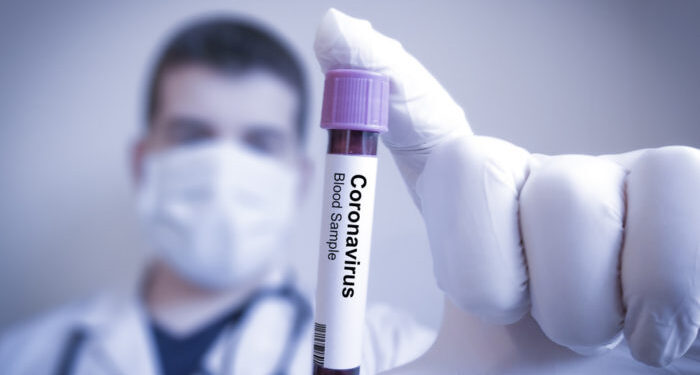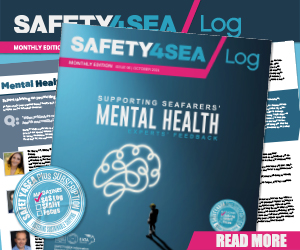The World Health Organization (WHO) has recently shared operational considerations for managing COVID-19 cases and outbreaks onboard ships. This document is based on the evidence currently available about coronavirus transmission and is to be used in conjunction with the published WHO Handbook for management of public health events onboard ships.
The target audience of this documents is any authority involved in public health response to a COVID-19 public health event on board ships, including International Health Regulations (IHR) National Focal Point (NFP), port health authorities, local, provincial and national health surveillance and response system, as well as port operators and ship operators.
Outbreak management plan for COVID-19 disease
Passenger ships sailing on an international voyage are advised to develop a written plan for disease outbreak management that covers the definitions of a suspected case of COVID-19 disease, the definition of close contacts and an isolation plan.
The outbreak management plan should include descriptions of the following:
- the location or locations where suspected cases will be isolated individually until disembarkation and transfer to a healthcare facility;
- how the necessary communications between departments (for example, medical, housekeeping, laundry, room service) about persons in isolation will be managed;
- the clinical management of suspected cases while they remain onboard;
- cleaning and disinfection procedures for potentially contaminated areas, including the isolation cabins or areas;
- how close contacts of the suspected case will be managed;
- procedures to collect Passenger/Crew Locator Forms (PLF);
- how food service and utensils, waste management services and laundry will be provided to the isolated travellers. Staff on board should have knowledge of the outbreak management plan and should implement it as required.
Prior to boarding
-Pre-boarding information: Passengers and crew members should receive information in accordance with WHO’s advice for international traffic in relation to the outbreak of COVID-19 disease. This advice and guidance is available at https://www.who.int/health-topics/coronavirus.
-Pre-disembarkation information: Until the termination of the COVID-19 public health emergency of international concern is declared, it is recommended that all passengers and crew members complete their PLF, and this should be kept on board for at least 1 month after their disembarkation.
-Pre-boarding screening: Until the termination of the COVID-19 outbreak, passenger ships on an international voyage are advised to provide passengers with general information on COVID-19 disease and preventive measures and to implement pre-boarding screening with the purpose of deferring or rescheduling the boarding of any traveller identified through a questionnaire as being a close contact of someone with COVID-19 disease to ensure proper management by port health authorities.
-Education: Ship owners should provide guidance to the crew about how to recognize the signs and symptoms of COVID-19 disease.
Disembarkation of suspected cases
A suspected case is:
- a patient with severe acute respiratory infection (that is, fever and cough requiring admission to hospital) AND with no other aetiology that fully explains the clinical presentation AND a history of travel to or residence in China or in another country with established community transmission1 of COVID-19 disease during the 14 days prior to symptom onset
- a patient with any acute respiratory illness AND at least one of the following during the 14 days prior to symptom onset: (a) contact with a confirmed or probable case of COVID-19 disease or (b) working in or visiting a healthcare facility where patients with confirmed or probable COVID-19 disease were being treated.
During the disembarkation of suspected cases, every effort should be made to minimize the exposure of other persons and environmental contamination.
Suspected cases should be provided with a surgical mask to minimize the risk of transmission.
Staff involved in transporting suspected cases should apply infection control practices by following WHO’s guidance:
- When loading patients into the ambulance, transport staff, including medical staff, should routinely perform hand hygiene and wear a medical mask, eye protection (goggles or a face shield), a long-sleeved gown and gloves.
- Personal protective equipment (PPE) should be changed after loading each patient and disposed of appropriately in containers with a lid and in accordance with national regulations for disposing of infectious waste.
- The driver of the ambulance must remain separate from the cases (keeping at least 1 m distance). No PPE is required if distance can be maintained or a physical separation exists. If drivers must also help load the patients into the ambulance, they should follow the PPE recommendations in the previous point.
- Transport vehicles must have as high a volume of air exchange as possible (for example, by opening the windows).
- Transport staff should frequently clean their hands with an alcohol-based hand rub or soap and water and ensure that they clean their hands before putting on PPE and after removing it.
- Ambulances and transport vehicles should be cleaned and disinfected, with particular attention paid to the areas in contact with the suspected case. Cleaning should be done with regular household soap or detergent first and then, after rinsing, regular household disinfectant containing 0.5% sodium hypochlorite (that is, equivalent to 5000 ppm or 1 part bleach to 9 parts water) should be applied.
Measures onboard the ship
In the event that the affected ship calls at a port other than the turnaround port, the port health authority should conduct a risk assessment and may decide in consultation with the ship’s owner to end the cruise.
The ship should be inspected according to Article 27 of the IHR (2005), which discusses affected conveyances, and then health measures (such as cleaning and disinfection) should be applied based on the findings of the inspection.
The next voyage can start after thorough cleaning and disinfection have been completed. Active surveillance should take place on board the ship for the following 14 days.
Additionally, the ship’s owner could explore the possibility of starting the next voyage with a new crew onboard, if this is feasible.
In accordance with WHO’s guidance about infection prevention and control during health care when COVID-19 infection is suspected (6), medical facilities, cabins and quarters occupied by patients and close contacts of a confirmed case with COVID-19 disease should be cleaned and disinfected daily, and cleaning and disinfection should be carried out after they have disembarked.
The remainder of the ship should also be cleaned and disinfected, particularly when an outbreak occurs.
Laundry, food service utensils and waste from the cabins of suspected cases and their contacts should be handled as if infectious and according to the outbreak management plan provided on board for other infectious diseases (for example, for norovirus gastroenteritis).
It is essential that the ship remains at the port for the time required to thoroughly clean and disinfect it.
A ship that is considered to have been affected shall cease to be regarded as such when the port health authority is satisfied with the health measures undertaken and when there are no conditions onboard that could constitute a public health risk.
Highlighting the urgency of the coronavirus outbreak, WHO has increased its assessment of the risk of spread and impact of the virus to ‘very high’ at a global scale.
Further details may be found herebelow:


































































